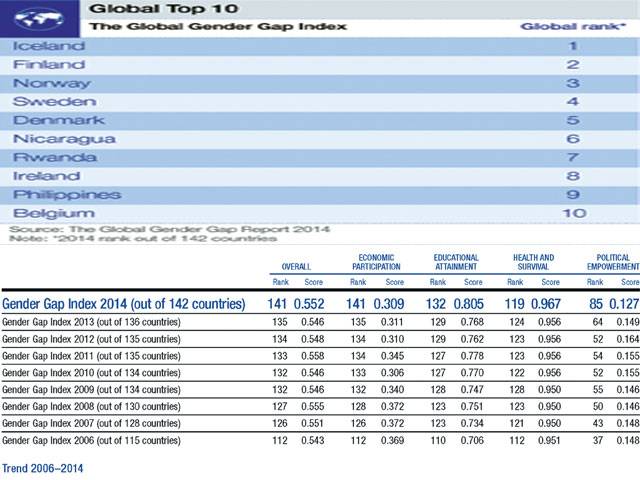NEW YORK - Pakistan is ranked second to last in terms of gender equality worldwide in a report released on Tuesday by the World Economic Forum.
The annual Gender Gap Index by the Geneva-based Forum released showed Pakistan ranked 141 out of 142, second to last in global gender equality.
This is the third year in a row that Pakistan has maintained the second to last ranking.
The only country where women face worse equality issues is Yemen.
Neighbouring India's ranking fell from 101st out of 136 countries surveyed last year to 114th out of 142 countries this year.
In nine years of measuring the global gender gap, the world has seen only a small improvement in equality for women in the workplace, the report said. The gender gap for economic participation and opportunity now stands at 60 per cent worldwide, having closed by 4 per cent from 56 per cent in 2006 when the Forum first started measuring it.
Based on this trajectory, with all else remaining equal, it will take 81 years for the world to close this gap completely.
The ninth edition of the report finds that, among the 142 countries measured, the gender gap is narrowest in terms of health and survival. This gap stands at 96 per cent globally, with 35 countries having closed the gap entirely. This includes three countries that have closed the gap in the past 12 months. The educational attainment gap is the next narrowest, standing at 94 per cent globally. Here, 25 countries have closed the gap entirely. While the gender gap for economic participation and opportunity lags stubbornly behind, the gap for political empowerment, the fourth pillar measured, remains wider still, standing at just 21 per cent, although this area has seen the most improvement since 2006.
With no country having closed its overall gender gap, Nordic nations remain the most gender-equal societies in the world. Last year’s leading four nations – Iceland (1), Finland (2), Norway (3) and Sweden (4) – are joined by Denmark, which climbs from eighth place to fifth. Elsewhere in the top 10 there is considerable movement, with Nicaragua climbing four places to sixth, Rwanda entering the index for the first time at seventh, Ireland falling to eighth, the Philippines declining four places to ninth and Belgium climbing one place to tenth.
Further up the index, the United States climbs three places to 20 in 2014, after narrowing its wage gap and improving the number of women in parliamentary and ministerial level positions. Among the BRICS grouping, the highest-placed nation is South Africa (18), supported by strong scores on political participation. Brazil is next at 71, followed by Russia (75) and China (87).
Countries from Europe and Central Asia occupy 12 of the top 20 positions in the index, one less than last year. Of the region’s major economies, Germany climbs two places to 12th, France leaps from 45th to 16th, while the UK falls eight places to 26th. France’s gain is mostly due to increases in the number of women in politics, including 49 per cent women ministers – one of the highest ratios in the world, and narrowing wage gaps. The UK’s lower position can be mainly attributed to changes in income estimates.
In Asia and the Pacific, the Philippines remains the region’s highest-ranked country, followed by New Zealand (13) and Australia (24).
These nations are regional outliers, however, as only one other nation, Mongolia (42), places in the top 50. Singapore, the People’s Democratic Republic of Laos and Thailand come next in 59th, 60th and 61st place, respectively. Japan climbs one place to 104th; China falls 18 places to 87th, largely due to its very low sex ratio at birth; and India slumps to 114th, making it the lowest-ranked BRICS nation and one of the few countries where female labour force participation is shrinking.
Wednesday, April 17, 2024
After Yemen, Pakistan ranks worst in gender gap report

Pride and hype as F1 roars back to China after Covid absence
10:36 PM | April 16, 2024
No let-up in Karachi street crime incidents
10:35 PM | April 16, 2024
Stock market today: Most of Wall Street weakens again as Treasury yields rise more
10:34 PM | April 16, 2024
Muslim K-popstar Daud Kim buys land to build mosque in South Korea
10:33 PM | April 16, 2024
Punjab Stadium unavailability derails National Challenge Cup 2023 Final Round
10:28 PM | April 16, 2024
Political Reconciliation
April 16, 2024
Pricing Pressures
April 16, 2024
Western Hypocrisy
April 16, 2024
Policing Reforms
April 15, 2024
Storm Safety
April 15, 2024
Democratic harmony
April 16, 2024
Digital dilemma
April 16, 2024
Classroom crisis
April 16, 2024
Bridging gaps
April 16, 2024
Suicide awareness
April 15, 2024
ePaper - Nawaiwaqt
Advertisement
Nawaiwaqt Group | Copyright © 2024





